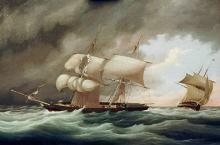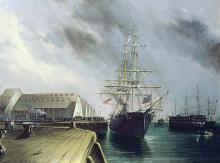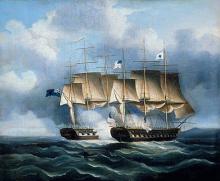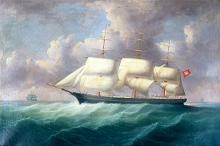Stories Told by Marine Paintings
Marine paintings often tell a story. Painted probably around 1850 by Englishman E. Poulson, this painting tells a grim tale. It shows a slave ship under attack by a British Royal Navy anti-slavery squadron brigBrig
Vessel with two masts; both square-rigged.. A close look shows some African crew members, as well as slaves being taken from the hold and forced to sit beneath the windward rail to increase stability. Gathering the slaves on deck would have also made it easy to throw them overboard, a common practice when a slave ship was in danger of capture.
A painting by James Buttersworth, HMS Monarch in Portsmouth, tells a story about a wealthy philanthropistPhilanthropist
A person who actively tries to promote human welfare., George Peabody, from what is now Peabody, Massachusetts. Peabody, who contributed heavily to English charities, died in England in 1869. A grateful Queen Victoria directed Prime Minister Gladstone to order Britain’s newest warship, the HMS Monarch, to bring his body back to the United States. This painting shows the casket being carried through the crowd.
Naval paintings often show a battle at sea. Thomas Buttersworth Sr.’s painting of the USS President & HMS Endymion tells a story of the War of 1812.
The Endymion was launched on the Thames in 1797, a 40-gun British frigateFrigate
A full-rigged vessel of war carrying 24-50 guns. In size, a frigate was between a corvette and a ship-of-the-line.
Read more. carrying a crew of 320 men. The President was a 44-gun American frigate built in New York in 1800. This vessel fired the first shot of the War of 1812 during a skirmish on June 23, 1812. On January 14, 1815 the President was commanded by Stephen Decatur when she grounded on a sand bar off Sandy Hook. Decatur freed the vessel, but she was then pursued by four English vessels, including the Endymion, whom she defeated in a running battle. Eventually the President surrendered to the remaining three English vessels. Ironically, the war was over when the President was captured, but no one knew a peace treaty had been signed.
The Senator Weber was built in Boston in 1853 as the ship Wellfleet. In 1864, to escape Confederate raiders, Captain Henry S. Rich of Bucksport, Maine, registered the Wellfleet in Hamburg, Germany. She was renamed Senator Weber, and flew the flag of Hamburg, which had its own merchant fleet. At this time it would have made sense to overpaint the American flag in the ship portrait, and change or hide the name. Look carefully at the top of the main mast: can you see the name flag painted over with clouds?




